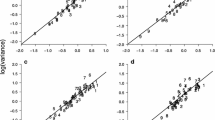Abstract
The ability to precisely describe forest spatial structures, and their modifications through timber harvesting, is of prime importance for sustainable management of complex forest ecosystems, especially regarding uneven-aged, multi-species forests. For this purpose, forest managers require statistical indices that are meaningful descriptors of the spatial structure of a given forest ecosystem. This paper presents a new sensitive permutation test of spatial randomness for solving the classification problem of three nearest neighbour-based indices. The test enables a categorisation of a spatial pattern as a whole into one of three groups: regular, random or cluster, with a sensitivity comparable to that of Ripley’s L test, at finer scales. The examples illustrate how the Clark and Evans, the uniform angle, and the mean directional indices can be used for precise detection of departure from spatial randomness. The results show that these three indices should be used simultaneously because they are sensitive to slightly different types of processes.



Similar content being viewed by others
References
Aguirre O, Hui GY, Gadow Kv, Jimenez J (2003) An analysis of spatial forest structure using neighbourhood-based variables. For Ecol Manage 183:137–145
Albert M (1999) Analyse der eingriffsbedingten Strukturveränderung und Durchforstungsmodellierung in Mischbeständen. Doctoral dissertation, University of Göttingen, Germany
Biondi F, Meyers DE, Avery CC (1994) Geostatistically modeling stem size and increment in an old growth forest. Can J For Res 24:1354–1368
Clark PJ, Evans FC (1954) Distance to nearest neighbour as a measure of spatial relationships in populations. Ecology 35:445–453
Corral-Rivas JJ (2006) Models of tree growth and spatial structure for multi-species, uneven-aged forests in Durango (Mexico). PhD thesis, University of Göttingen
Crecente-Campo F, Pommerening A, Rodríguez-Soalleiro R (2009) Impacts of thinning on structure, growth and risk of crown fire in a Pinus sylvestris L. plantation in northern Spain. For Ecol Manage 257:1945–1954
Cressie N (1991) Statistical for spatial data. Wiley, New York
Diggle PJ (1983) Statistical analysis of spatial point patterns. Academic, London
Gadow Kv (2005) Das Mehrpfadprinzip der Forsteinrichtung. Allg Forst- Jagd Z 9:469–471
Gadow Kv, Pogoda P (2000) Assessing forest structure and diversity. Man For 1:1–8
Gadow Kv, Hui GY, Albert M (1998) Das Winkelmass—ein Strukturparameter zur Beschreibung der Individualverteilung in Waldbeständen. Centralbl Gesamte Forstwes 115:1–9
Gignoux J, Duby C, Barot S (1999) Comparing the performances of Diggle’s tests of spatial randomness for small samples with and without edge-effect correction: application to ecological data. Biometrics 55:156–164
Gordon AG (1968) Ecology of Picea chihuahuana Martinez. Ecology 49:880–896
Gregorius HR, Degen B, König A (2007) Problems in the analysis of genetic differentiation among populations—a case study in Quercus robur. Silvae Genet 56:190–199
Hui GY, Gadow Kv (2002) Das Winkelmass—Herleitung des Optimalen Standardwinkels. Allg Forst- Jagd 10:173–177
Hui GY, Hu YB (2001) Measuring species spatial segregation in mixed forest. For Res 14:23–27
Hui GY, Albert M, Chen BW (2003) Reproduktion der Baumverteilung im Bestand unter Verwendung des Stukturparameters Winkelmaß. Allg Forst- Jagd 174:109–116
Kint V, Marc Mv, Lieven N, Guy G, Noel L (2003) Spatial methods for quantifying forest stand structure development: a comparison between nearest-neighbor indices and variogram analysis. For Sci 49:36–49
Kuuluvainen T, Pukkala T (1987) Effect of crown shape and tree distribution on the spatial distribution of shade. Agric For Met 40:215–231
Manly BFJ (1997) Randomization, Bootstrap and Monte Carlo methods in biology. Chapman and Hall, London
Mecke K, Stoyan D (2005) Morphological characterisation of point patterns. Biom J 47:1–16
Moeur M (1993) Charaterizing spatial patterns of trees using stem-mapped data. For Sci 39:756–775
Newton PF, Jolliffe PA (1998) Assessing processes of intraspecific competition within spatially heterogeneous black spruce stands. Can J For Res 28:259–275
Penttinen AK, Stoyan D, Henttonen HM (1992) Marked point processes in forest statistics. For Sci 38:806–824
Pommerening A (2002) Approaches to quantifying forest structures. Forestry 75:305–324
Pommerening A (2006) Evaluating structural indices by reversing forest structural analysis. For Ecol Manage 224:266–277
Pommerening A, Stoyan D (2006) Edge-correction needs in estimating indices of spatial forest structure. Can J For Res 36:1723–1739
Pretzsch H (1995) Zum Einfluss des Baumvertielungsmusters auf den Bestandszuwachs. Allg Forst- Jagd 166:190–201
Ripley BD (1977) Modeling spatial patterns (with discussion). J R Stat Soc Ser B 39:172–212
Ripley BD (1981) Spatial statistics. Wiley Series in probability and mathematical statistics. Wiley, New York
Spellmann H (1995) Vom strukturarmen zum strukturreichen Wald. Forst Holz 50:35–44
Stamatellos G, Panourgias G (2005) Simulating spatial distributions of forest trees by using data from fixed area plots. Forestry 78:304–302
Stoyan D, Stoyan H (1994) Fractals, random shapes and point fields. Wiley, Chichester
Upton G, Fingleton B (1985) Spatial data analysis by example. Vol. 1: point pattern and quantitative data. Wiley, New York
Upton G, Fingleton B (1989) Spatial data analysis by example. Vol. 2: categorical and directional data. Wiley, New York
Wehenkel C, Corral-Rivas JJ, Castellanos-Bocaz H, Pinedo A (2009) Is there a positive relationship between naturalness and genetic diversity in forest tree communities? Invest Agrar Sist Recur For 18:20–27
Acknowledgments
This work was supported by the Fondo Sectorial CONAFOR-CONACYT and by the Fondo de Cooperación Internacional en Ciencia y Tecnología entre la UE-México (projects: 115900 and 92739). We are also grateful to an anonymous referee for valuable comments on an earlier version of this paper. Furthermore, we thank Prof. Dietrich Stoyan for the friendly support and good advice on spatial statistics given to the first author during his stay in Germany, and for providing some of the data used in this study.
Author information
Authors and Affiliations
Corresponding author
About this article
Cite this article
Corral-Rivas, J.J., Wehenkel, C., Castellanos-Bocaz, H.A. et al. A permutation test of spatial randomness: application to nearest neighbour indices in forest stands. J For Res 15, 218–225 (2010). https://doi.org/10.1007/s10310-010-0181-1
Received:
Accepted:
Published:
Issue Date:
DOI: https://doi.org/10.1007/s10310-010-0181-1




